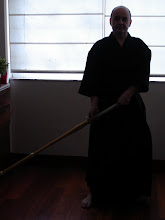Chūdan-no-kamae(中段の構え:ちゅうだんのかまえ), occasionally Chūdan-gamae, or simply Chūdan it is shortened to in many Japanese martial arts schools that instruct in the use of the katana(sword). Chūdan-no-kamae translates to "middle-level posture." In most traditional schools of swordsmanship, and in the practice of kendo, chūdan-no-kamae is the most basic posture. It provides a balance between attacking and defensive techniques.
Chūdan-no-kamae is one of the five stances in kendo: jōdan, chūdan, gedan, hassō and waki.
This is the most basic stance in kendo which balances attack and defence. If correctly assumed, the trunk (do) and right wrist (migi-kote) are hidden from the opponent. The throatis visible, but the extended tip of the sword threatens a thrusting enemy with a likely counter-thrust. The head (men) is the only clearly open target, but this too is easily defended. If the kamaeis not broken, the user can step into striking distance of the opponent whilst maintaining good defence.
A beginner learns this stance first in order to learn the correct striking distance, issoku-itto-no-maai.
Body position
In chūdan-no-kamae, the left foot is slightly behind the right with the left heel slightly raised, both feet are parallel, the hips are straight forward, shoulders are relaxed, spine is perpendicular to the floor at all times. The center of gravity should be centered between both feet.
The shinaiis held with the hands in front of the waist, with the tip of the weapon pointed at the opponent's throat.





No hay comentarios:
Publicar un comentario